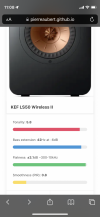Vacceo
Major Contributor
- Joined
- Mar 9, 2022
- Messages
- 2,666
- Likes
- 2,820
It is an interesting observation, particularly on the dynamic range. The guys from Audioholics typically consider KEF as particularly lacking on that regard.Absolutely incredible soundstage and dynamic range (particularly noticeable with a symphony orchestra) compared to an aging (and in need of a crossover rebuild) pair of Kef 104/2s. I am seriously astonished by the LS50meta crossed over at 80Hz to subs. To the extent that my center channel speaker (Focal Chora) is being replaced by an LS50meta also. Medium size room (15*15*8 with openings on 3 corners).
Not that I complain, as I use the active version and I'm very happy with them.

